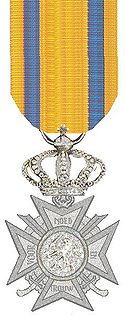
The Military William Order, or often named Military Order of William, is the oldest and highest honour of the Kingdom of the Netherlands. It is named after St. William of Gellone (755–814), the first Prince of Orange. Its motto is Voor Moed, Beleid en Trouw. The chivalric order was established on 30 April 1815 by King William I and was presented for feats of excellent bravery on the battlefield and as a meritorious decoration to senior military officers. Comparable with the French Légion d’Honneur but far less often awarded, it is open to everyone regardless of rank or nobility—not only to Dutch military, but also to foreigners. To date, membership in the Order is extremely rarely awarded, and only for exceptional bravery in battle.

The Order of Orange-Nassau is a civil and military Dutch order of chivalry founded on 4 April 1892 by the queen regent, Emma of the Netherlands.

The fourragère is a military award, distinguishing military units as a whole, in the form of a braided cord. The award was first adopted by France, followed by other nations such as the Netherlands, Belgium, Portugal, and Luxembourg. Fourragères have been awarded to units of both national and foreign militaries, except for that of Luxembourg, which has not been awarded to any foreign units.
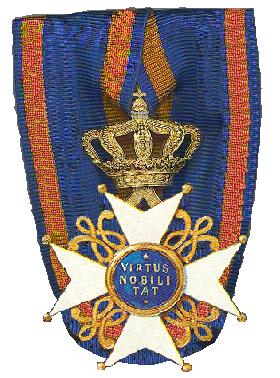
The Order of the Netherlands Lion, also known as the Order of the Lion of the Netherlands is a Dutch order of chivalry founded by William I of the Netherlands on 29 September 1815.

The Order for Loyalty and Merit is a house order of the Dutch Royal House of Orange-Nassau. The Order came into being as a result of Queen Juliana's reorganization of The House Order of Orange in 1969.
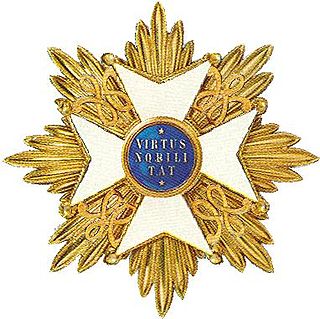
In the Dutch honours system, most orders are the responsibility of ministers of the Netherlands Government. The house orders, however, are awarded at the discretion of the Dutch monarch alone.
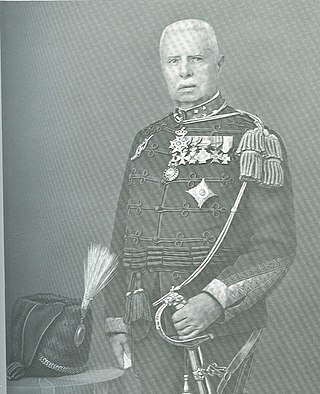
The Honorary Sabre is one of the highest military awards for bravery in the Kingdom of the Netherlands. Only knights of the Military William Order are eligible to receive this sabre. The King awards this highly decorated sabre to a military officer who will wear this together with his uniform.
The Honorary Medal for Charitable Assistance was created at 18 June 1822 and is after the Military William Order the oldest decoration for bravery in the Kingdom of the Netherlands. Furthermore, the Honorary Medal is the highest civilian decoration still being awarded for bravery, and is specifically for those who carried out a voluntary act of bravery or self-sacrifice, with an emphasis on charity.
The Airman's Cross is a military decoration of the Kingdom of the Netherlands created in 1941. The cross is awarded to members of the Dutch military who display initiative, courage, and perseverance against the enemy or during hostile actions during one or more flights. The cross is also awarded to allied pilots whose actions were of high importance to the Netherlands.
The Honorable Mention was an important Military awards and decorations of the Kingdom of the Netherlands for those who distinguished themselves by acts of high bravery, but weren't eligible yet for the highest accolade of the Military William Order. The Honorable Mention was in fact not a medal but a mention in the proclamation of the Dutch army, to honor the soldier.
A colonial order of chivalry was an order of chivalry awarded by European colonial states in Africa and Asia for those who conquered and administered their territories. They were sometimes adopted by post-colonial successor states, or remained one of the former imperial power's orders of chivalry. The orders of the states of the Commonwealth are not colonial orders, and owe their existence to their nations' personal union with the United Kingdom or to their own governments or parliaments.
The Star for Loyalty and Merit was a civilian award established on 1 January 1894 by Governor-General Carel Herman Aart van der Wijck of the Dutch East Indies. The star replaced the old Medal for Civil Merit, which had limited prestige and status according to the Netherlands government. The star was awarded in gold to "significant and meritorious" natives, and in silver to village chiefs and leaders of the "Eastern foreigner" communities. Dutch (Europeans) were not eligible to receive the star.

The Cross for the Four Day Marches is an official Dutch decoration awarded for successful participation in the International Four Days Marches held annually at Nijmegen, The Netherlands. The full title of the decoration is Kruis Voor Betoonde Marsvaardigheid. It is more commonly referred to as the Vierdaagse Cross or Vierdaagsekruis.

The Orderly Medal of the Four Day Marches was awarded between in 1965 and 2016 by the KNBLO, or Royal Dutch League for Physical Education, to those who gave support to walkers participating in the International Four Days Marches held annually at Nijmegen, the Netherlands.
The Expedition Cross officially known as the Cross for Important Military Operations was a military decoration of Kingdom of the Netherlands. Created by royal decree on 19 February 1869, by King William III, the cross was awarded for participation in major military operations between 1846 and 1942.
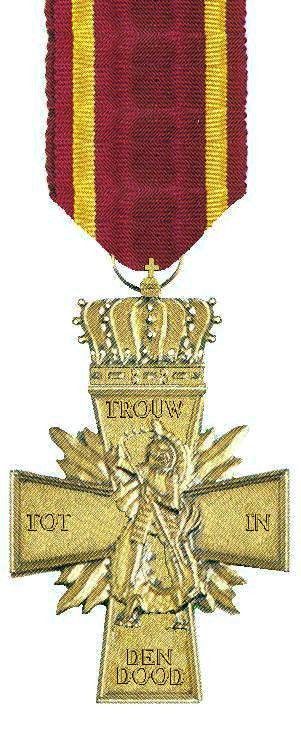
The Verzetskruis 1940–1945 is a decoration for valour in the Netherlands. Instituted on May 3, 1946, it was awarded in recognition of the individual courage shown in resistance against the enemies of the Netherlands and for the maintenance of liberties. It is one of the highest decorations in the Netherlands.
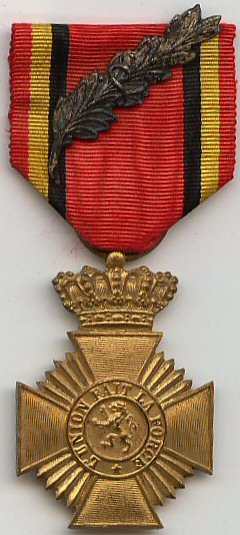
The Military Decoration for Exceptional Service or Acts of Courage or Devotion is awarded to personnel of the Belgian Armed Forces for either displayed herorism or for display of extraordinary devotion to duty. In history, sometimes it is referred to as an 'Article 4' award, as originally, the medal was created as a variation of the military decoration for long service. However, nowadays, both medals are distinct awards, albeit still having the same guilt cross.

The Decoration for Order and Peace is a military award of the Netherlands. The medal was established on 12 December 1947 by royal decree of Queen Wilhelmina. The medal commemorates at least three months of service in the Dutch East Indies and adjacent waters during the Indonesian National Revolution. It was awarded to members of the Netherlands Armed Forces and the Royal Netherlands East Indies Army. Recipients who were engaged with hostile parties in a military context could be awarded clasps indicating the year of the action.
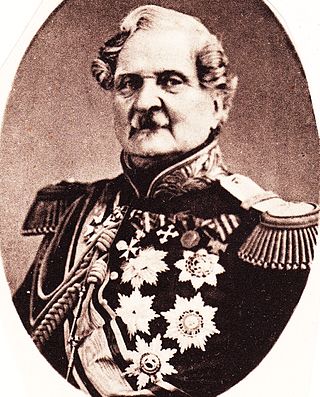
François Vincent Henri Antoine de Stuers was a Dutch general, commander of the Indies army.
